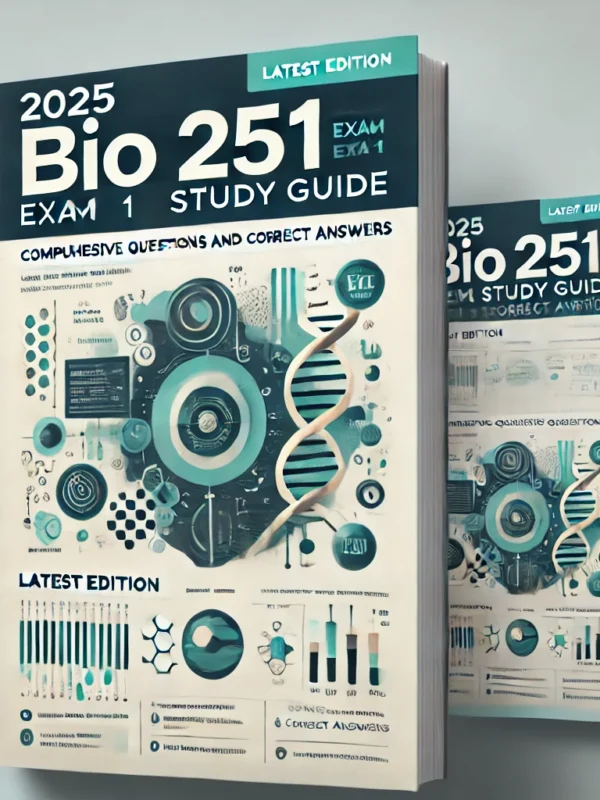Excel in your Rasmussen University nursing program with the NUR 2063 Essentials of Pathophysiology Exam 2: Accurate & Verified for Guaranteed Pass – Latest Update 2024-2025 (Rasmussen University). This targeted study resource is designed for students enrolled in NUR 2063 (Essentials of Pathophysiology) at Rasmussen University, providing a comprehensive set of accurate and verified questions specifically for Exam 2. Covering key pathophysiology topics such as cellular injury, inflammation, immune responses, infectious diseases, hematologic disorders, cardiovascular pathophysiology, respiratory disorders, and renal dysfunction, this guide ensures you’re fully prepared for the exam’s content and format. Each question is paired with detailed, verified answers and in-depth rationales, helping you understand the underlying mechanisms of disease processes and their clinical manifestations, which are crucial for nursing practice. The NUR 2063 Exam 2 typically includes 50–75 questions in formats like multiple-choice, select-all-that-apply, and case-based scenarios, and this resource mirrors that structure to provide an authentic practice experience. Verified by top Rasmussen students, this study guide guarantees a passing score through a structured, focused approach to preparation. Updated for the 2024-2025 academic year, it aligns with the latest Rasmussen University curriculum, incorporating current pathophysiology concepts and clinical applications, making it the ultimate tool to help you succeed in NUR 2063 and build a strong foundation for your nursing career.
Preview
What are the functions of the kidneys?
• A) Regulation of blood pressure; regulating blood osmolarity; removal of toxins; blood
f
iltration; activate vitamin D (Correct Answer)
• B) Production of bile
• C) Regulating body temperature
• D) Storage of glucose
Rationale: The kidneys are essential for regulating blood pressure, filtering blood,
removing toxins, managing osmolarity, and activating vitamin D, making them vital for
overall homeostasis.
What are the clinical manifestations of benign prostatic hypertrophy?
• A) Incontinence; fever; abdominal pain
• B) Dribbling; difficulty initiating urine stream; hesitancy; urinary retention; decreased
stream (Correct Answer)
• C) Increased urination at night
• D) Hematuria
Rationale: The listed symptoms are characteristic of benign prostatic hypertrophy, which
causes urinary obstruction and difficulties.
What substance controls the reabsorption of water from the collecting ducts?
• A) Aldosterone
• B) ANP (Atrial Natriuretic Peptide)
• C) ADH (Anti-Diuretic Hormone) (Correct Answer)
• D) Cortisol
Rationale: ADH regulates water reabsorption in the kidneys, helping maintain fluid
balance in the body.
• A) Regulation of blood pressure; regulating blood osmolarity; removal of toxins; blood
f
iltration; activate vitamin D (Correct Answer)
• B) Production of bile
• C) Regulating body temperature
• D) Storage of glucose
Rationale: The kidneys are essential for regulating blood pressure, filtering blood,
removing toxins, managing osmolarity, and activating vitamin D, making them vital for
overall homeostasis.
What are the clinical manifestations of benign prostatic hypertrophy?
• A) Incontinence; fever; abdominal pain
• B) Dribbling; difficulty initiating urine stream; hesitancy; urinary retention; decreased
stream (Correct Answer)
• C) Increased urination at night
• D) Hematuria
Rationale: The listed symptoms are characteristic of benign prostatic hypertrophy, which
causes urinary obstruction and difficulties.
What substance controls the reabsorption of water from the collecting ducts?
• A) Aldosterone
• B) ANP (Atrial Natriuretic Peptide)
• C) ADH (Anti-Diuretic Hormone) (Correct Answer)
• D) Cortisol
Rationale: ADH regulates water reabsorption in the kidneys, helping maintain fluid
balance in the body.












Reviews
There are no reviews yet.